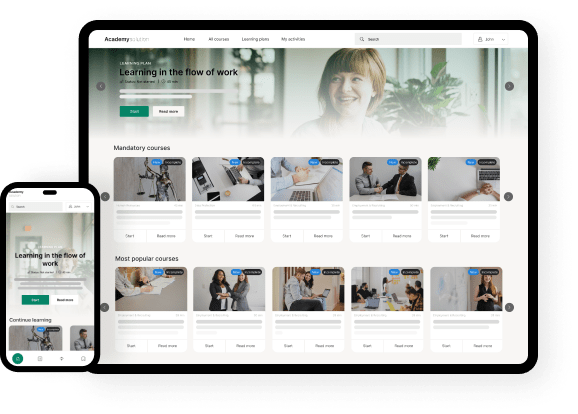Much talk about organizations adopting a “modern workplace” has cast speculations that machines would take away people’s jobs. However, a 2019 World Development Report has clarified that such concerns are unfounded.
Indeed, technological progress continues to reshape today’s nature of work. Workplace trends like virtual collaboration and a hybrid workplace constantly redefine the corporate landscape.
Nevertheless, the same Word Development Report says these disruptions and developments have created more prosperity than damage.
Therefore, it’s important not to shy away from or ignore these workplace trends.
And it’s equally essential not to reduce a modern workplace to a typical “science project”. Because it’s not just about technology.
So, what is it then?
In this post, we’ll answer all your questions about what a modern workplace is and how you establish a flourishing modern workplace culture. Let’s dig in!
What is a modern workplace?
To help you understand what a modern workplace means, let’s first review what a traditional workplace is.
A traditional workplace is everything you expect from a typical office environment — workers logging in and out every day, computers, printers, and servers running twenty-four hours a week, and the smell of coffee lighting up a gloomy Monday morning.
Traditional office culture is often bureaucratic, highly output-driven, rigid, and structure-centric. And it’s in stark contrast with what today’s workplace culture embodies.
The term “modern workplace” is used to describe organizations that have embraced the reality of digital collaboration, solutions, and integration as the way of the future.

This new way of defining the workplace has paved the way for technologies supporting automation, digital workspaces, and hybrid work.
But again, a modern workplace isn’t about using artificial intelligence or advanced collaboration tools. It’s about creating a positive, collective, and flexible culture suited to the modern worker.
In other words, a modern workplace is a philosophy or an ethos empowering people to be the best version of themselves. To achieve this, though, organizations must provide their employees with the right resources, opportunities, and motivation.
Here’s where technology comes in, and the concept of a digital workplace is born.
What is a digital workplace?
Not only did the 2020 pandemic change the way we look at work, but it also blurred the line between the physical office and the place where work actually happens. It dissolved the distinction between professional and personal life.
As employees communicate and collaborate in unprecedented ways, companies began implementing an entirely different working environment — the digital workplace.
A digital workplace is the natural evolution of the traditional in-office environment. It encompasses all activities people would do in a physical office; except they’re carried out virtually using digital workplace solutions.
Digital workplace solutions can be as simple as e-learning platforms, online collaboration tools, and project management software. If implemented correctly, these solutions can help organizations increase agility, flexibility, productivity, and revenue — and even scale their business.

Factors that changed the workplace forever
The workplace has been in continuous flux since the agricultural and industrial revolutions. The digital workplace, however, is a relatively young concept, spurred on by the emergence of these three main factors:
The aging workforce
The changing workplace demographics can impact the labor market immensely. The effects of having an aging workforce, for example, can lead to labor shortages and skills gaps across industries. To address these issues, some companies have turned to technology to:
- Improve employees’ health and extend their longevity
- Transform work and the workplace to create a supportive environment for learning
- Support labor market infrastructure
The efforts to improve workers’ health and retention inspired organizations to provide more flexibility in work preferences, leading to today’s hybrid workplace trend.
A hybrid workplace model combines in-office and remote work to give workers more autonomy and work-life balance. Hybrid workplace technologies can include:
- Applicant tracking systems
- Communication platforms
- File-sharing or document management tools
- Human capital management software
- Learning Management Systems (LMS)
Thorough use of automation also makes jobs and tasks less physically and mentally demanding for older employees, letting them extend their longevity.
Similarly, modern technology has played a vital role in tackling the skill gap issues in the workplace. Integrating technology in corporate training has made the employee learning experience more engaging and immersive. And with the advent of e-learning and various e-learning tools, knowledge has never been more accessible.
Information overload
In a recent study, 65.2 % of UK employees said their work is negatively affected by the high amount of data they must process.
Not only that, but 91 % of US workers admit that they sometimes delete or discard work-related information without fully reading it.
This shows that businesses, whether startups or large companies, can be prone to information overload or “infobesity”. That can be due to:
- The excessive information shared in the workplace
- The amount of irrelevant information exchanged at work
- Lack of time given to employees to process data
To solve this dilemma, company leaders had to develop fast and reliable ways to analyze and make data more valuable. Their strategy included:
- Maximizing targeted communication by using inbox rules
- Managing and contextualizing data through artificial intelligence
- Having an AI knowledge management system to answer questions effectively
- Creating a central data repository for business with cloud data storage technology
Information is still growing at exponential rates. And employees are still at risk of infobesity.
Fortunately, there are ways to overcome these hurdles, and various technologies are still being built to counter such issues.
The accelerating pace of the work environment
Sometimes, the market pressure for some companies isn’t just intense; it’s unforgiving. To dominate their competitors, they often take on more than they can handle. As a result, they speed up every process to raise performance goals and shorten innovation cycles.
With the rapid pace of today’s work environment, workers are also forced to perform faster and collaborate more to get optimum results. But this chronic acceleration is not without dire consequences. Some fall into a phenomenon called “the acceleration trap”.
Recognizing that the workplace isn’t a pressure cooker, some saw the importance of creating reliable software tools to aid large-scale project management.
Cloud tools like KissFlow, Trello, Asana, and ClickUp have been helping businesses plan projects properly, allocate tasks, and manage their time.
These project management tools come in handy when measuring and organizing your team’s capacity. With the right solution, you can visualize the entire scope of the project and assess possible risks throughout the process.
This critical development has laid the foundation for a key trend in the 21st-century workplace — virtual collaboration.
Virtual collaboration is a modern standard in present-day corporate practices, especially in digital workplaces. And it has become a necessary system in recent years during the pandemic and subsequent lockdowns.
It has allowed painless and seamless communication and connection between people regardless of their geographical location. Digital collaboration tools have provided employees relief from the tedious, manual in-office operations that sometimes take a “lifetime” to complete.
How to move from a traditional to a modern workplace
What we’ve established so far is the idea that a modern workplace is more of a cultural shift than a retrofitting process. Of course, technology plays a significant role in enabling change. But everything is about mindset, drive, communication, culture, and leadership.
Remember, mixing technology with an unwieldy organizational system will not change anything or solve any problem.
But how do you practically move from a traditional to a modern workplace then?
Building a successful modern workplace culture starts by supporting new approaches to solve issues and find value in new ways.
It begins with optimizing your current system and then finding the best way to harness the right technology suited for your specific business needs.
Let’s take The Danish Sailing Association as an example.
A modern workplace empowers people
The Danish Sailing Association is the national configuration for sailing. To support the development of sailing in a broader sense, they provide services directly to sailors, member clubs, affiliated school classes, and other organizations.
Their services cover developing the individual’s skills on the water, access to knowledge and education, and training for selected teams and sailors.
The Danish Sailing Association had mainly depended on external course providers for a long time. They didn’t have the means to set up courses and exams for their members themselves, which made their workflow unnecessarily complicated and inefficient.
To solve this issue, they sought a faster and more efficient solution to start and maintain new projects. In the process, they’ve partnered with Cursum to build an online academy that could handle everything from content creation to distribution.
Their online academy has helped them create a system in their association that eventually allowed them to utilize their resources with higher efficiency.
Rather than sticking with their external course providers, The Danish Sailing Association acquired a unified learning universe that serves as a solid supplement to their existing offline activities and in-person service offerings.
By having an online academy that enables them to create courses and exams by themselves, they’re able to work quickly and efficiently. Cursum’s online solution has also helped them increase their performance and grow their association from the inside out.
Modern workplace in a nutshell
The more you reflect on the current developments in the workplace, the more you’ll realize that:
- Employers will have to meet the varying needs of the multi-generational workplace as workplace demographics shift
- The rate of internet usage will constantly shoot up and cause more disruptions
- The working pace will hardly slow down
- Data distribution and consumption would soon reach an all-time high
There’s no getting around these realities. And with new thinking giving birth to more tech, we can be sure to expect more mind-blowing progress.
So, if the wind of change continues to blow, would you build a wall or a windmill?
A mill best represents our desire and effort to establish the best working environment possible. The wind, on the other hand, symbolizes the forces that relentlessly transform the workplace.
The various components of a windmill signify modern workplace synergies and the technologies that enable them.
And to harness the power of the wind, it’s crucial that your company is well-equipped.
At Cursum we’ve specialized in digital workplace solutions.
Our online academy, for example, can:
- Support scalability
- Increase your work efficiency
- Offer greater flexibility
- Optimize the employee experience
- Help you minimize spending and enhance productivity
Now, the question is, are you ready to take the next step and embrace this modern cultural shift?


